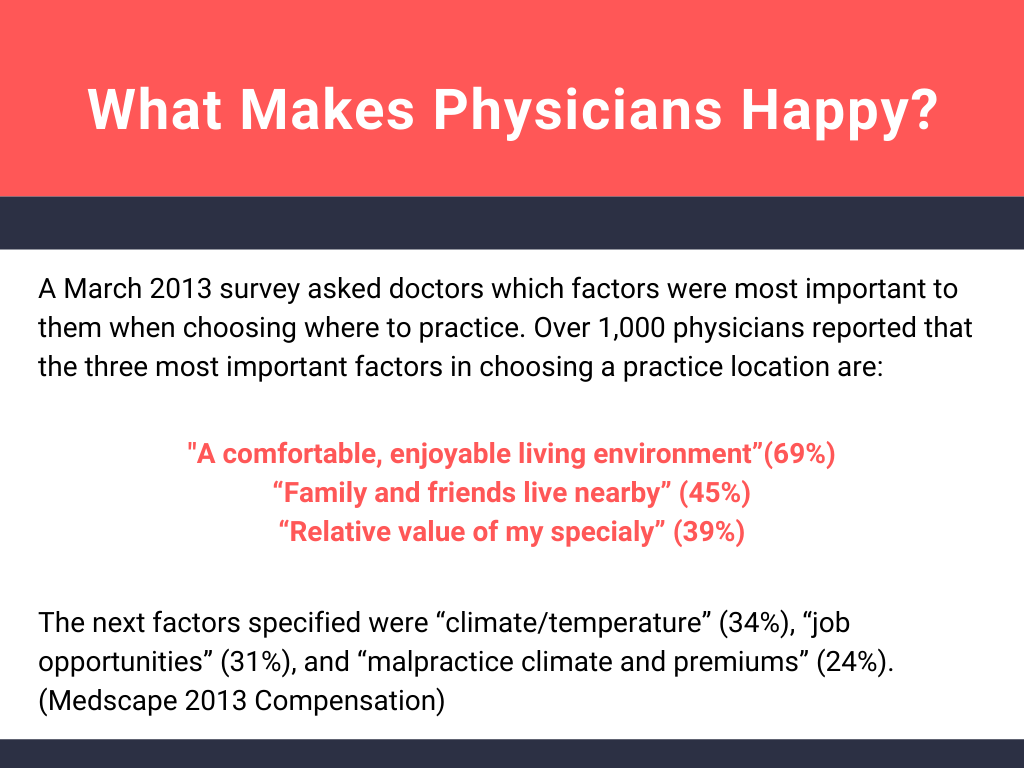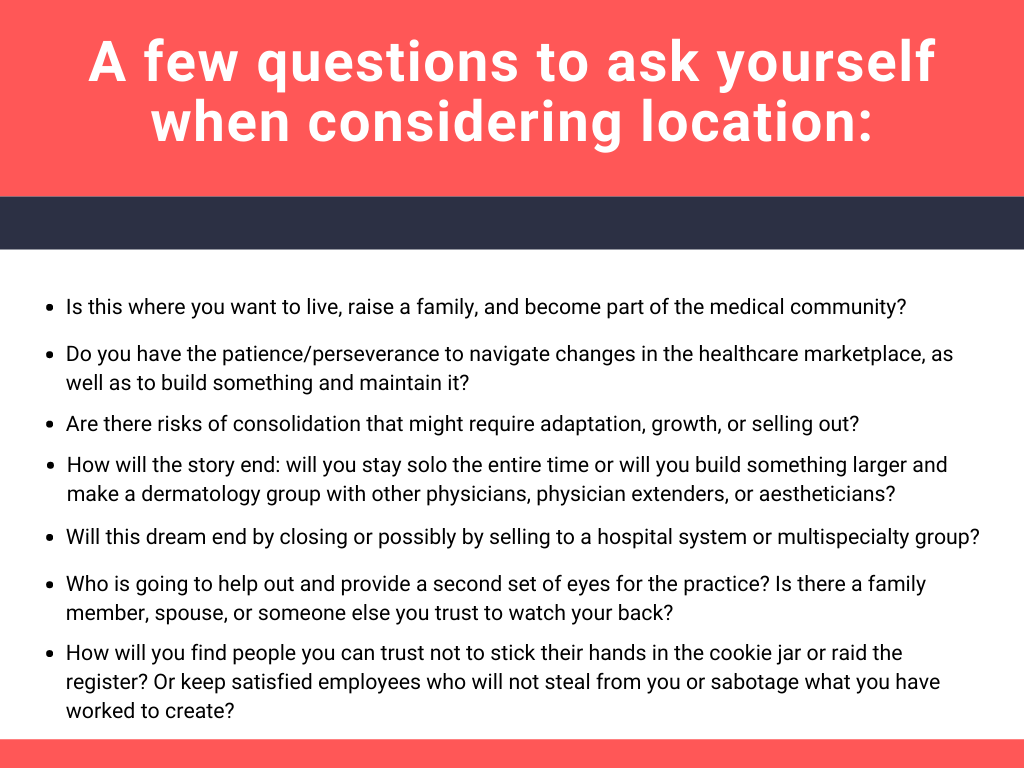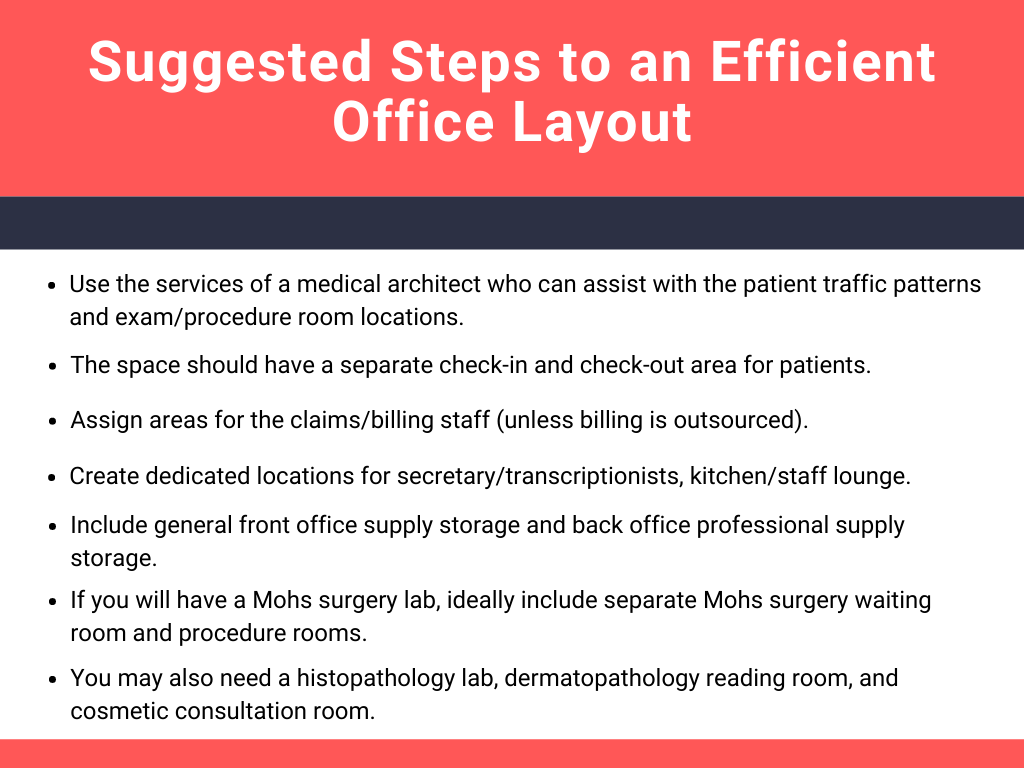The dermatology resident finishing his or her training faces many choices and opportunities for practice. This article reflects the experience of a dermatologist in private practice for over 40 years, covering the key issues in the decision-making process that culminates in a functional and desirable office space. Although this process applies primarily to those in private practice, the specifics of the features within that space are also applicable to an academic center clinic.
The Decision to Start a Practice
The decision to start the journey as a solo practitioner or to open a practice that might expand is often the most pivotal in a physician’s career. In many ways it is also the most daunting, given the relative lack of experience in business taught during medical school and training. However, with the correct vision, support, and motivation, the physician can wear both hats and can be successful.
The first steps in the journey are often filled with questions, and we can apply an analogy to the debate between evolution and creation. Evolutionists believe in steps and development, which would mandate that a practice starts with vision and a mission, followed by implementation of a plan. Usually six months to a year of planning, financing, and struggle, as well as a balancing of current employment duties, are involved in the process, which can be both painstaking and rewarding. On the other hand, creationists believe that the events occur all at once, and this is analogous to a solo practitioner buying an existing or fledgling practice or, with assistance from a healthcare or hospital group, setting up in an underserved area.
There are no premonitions to reveal what the future holds, but it should at least be obvious that private practice will never resemble residency.
Unfortunately, there are no premonitions to reveal what the future holds, but it should at least be obvious that private practice will never resemble residency. The biggest wake-up call comes when the checkbook has to open for every expense that might once have been taken for granted in a training program or another clinic setting: every piece of gauze, every suture package, every marketing piece, and every other dollar spent comes from the production overhead, which can be frightening early on when the receivables do not come in as often as the bills. However, these growing pains can be tempered with efficiency and with slow growth that meets the market demands.
Aside from the financial issues, it is important to reflect on lessons learned in training and from other colleagues. It cannot be overstated that the new solo practitioner and physician businessman should duplicate the good things learned from others and improve on any errors and inadequacies observed in other practices. Patterns for office efficiency, patient flow, scheduling, charting, and other set-up issues need to be established early and altered to benefit the rate of growth.

Location Selection
Whether you are beginning a practice for the first time as a solo practitioner and planning your own office space, or whether you have been in practice for a few years and are already outgrowing your space, location is a primary consideration. You should look for a location that is optimum not only for your present needs but also for your foreseeable future needs. Your practice space should be a growing area with convenient transportation, adequate parking, and access for the elderly and handicapped. You want to avoid areas with traffic problems that will frustrate your daily commute or patient access.
Space considerations are critical in that there must be adequate square footage for an efficient layout with an optimum number of exam/procedure rooms. You should plan space to meet the needs of your ideal vision of practice style and preferred patient mix. If your interests are primarily medical or surgical, or include cosmetic services, Mohs surgery, dermatopathology, or even clinical trials, planning the space to address those needs from the beginning is well worth the effort.
Location, Location, Location
The simplest rule of business success is to know your market and plan to locate where the market will be in your favor—understanding market saturation, the potential to cultivate a referral base, and how to manage the expense and overhead issues with the location. Proximity to hospitals allows for cohesion with other specialties and access to referrals from primary care clinics that serve the area. Conversely, it might be wise to avoid starting a solo practice in an area dominated by groups or managed care clinics that may not use your services. For example, if the emphasis of your clinic is aesthetics, then a location away from higher populations of Medicare and Medicaid patients might be best; and also be aware of Day Spas and places where there is not much “vanity money.”

Understanding the community and the potential for either positive or negative growth is imperative. Starting out slowly and increasing is a far safer and more cost efficient strategy than leaving the starting gates with everything on offer, especially when that market is not tested. Aim to please by adding services that are new, but not all at once, since the untested market demographic new to cosmetic services may not respond to a blitz of
marketing. More importantly, the overhead has to be considered in the cost/benefit ratio and its potential impact on stimulating practice growth. Tracking your success from advertising on the Internet, on the radio, and in print will also help streamline your approach to the market. Analyzing the medical dermatology practice is just as pivotal.
Starting out slowly and increasing is a far safer and more cost efficient strategy than leaving the starting gates with everything on offer, especially when that market is not tested.
Monthly assessments should identify the best and worst plans, including the top 10 payers, as well as reimbursements for the top 25 procedure codes. Regular updating of spreadsheets that include codes, charges, allowables, reimbursements, and other parameters should be part of the office manager’s monthly report. Occasional calls to referral offices to check which plans are predominant helps you keep track of whom the primary doctors are seeing.
Office Planning
Leasing vs Owning
If you will be starting your own practice rather than joining an existing group, you will probably be leasing office space. The local hospital may be helpful in identifying available medical office space in the area. If you can locate a space on your own, without using a commercial real estate agent, you may be able to negotiate better rates with the landlord because he or she will not have to pay an agent’s commission. Ideally the space should allow for future expansion and have a renewable lease for as long as it continues to meet your needs. Sometimes a practice outgrows its present office space. Sometimes you find there is no room for a potential new associate or no adjacent space for expansion.
Compared with building your own space, leasing space in a medical office building has the advantage of requiring less initial capital outlay and less time to prepare. However, the disadvantages with leasing include no equity accumulation and no building depreciation deductions. If you are outgrowing your current space, you may face a decision as to whether to look for alternate space to lease or whether to find land to build your own space. This might be a single owner-occupied building or perhaps a multi-tenant medical office building that includes your own practice space and, as the owner, additional space to lease to other tenants.
A single owner-occupied building has the advantage of complete autonomy with no tenant concerns, and less capital cost than constructing a multi-tenant building. You also have the benefits of equity appreciation, deductible building depreciation, and normally easy street level patient access. The disadvantage may be the higher construction costs per square foot, since a multi-tenant building may have only one foundation and one roof but multiple floors for tenants.
Environment and Layout
Whether you build your own space, or buy or lease it and remodel, the planning process is the foundation for ensuring that the final office space will meet all your anticipated needs. The space should offer a professional working environment that is not only efficient, but pleasant and comfortable for patients, doctors, and staff. Location on one floor is ideal, and sub-specialty capabilities such as Mohs surgery or dermatopathology must be planned from the beginning.

Decisions need to be made in conjunction with the architect on lighting, hardware, doors, windows, sinks, cabinets, electrical outlets, computer wiring needs, and acoustics, as well as on audio systems and nurse call systems. While wireless electronics (e.g., computers, tablets, and communication systems) are gaining ground, placement of the current highest standard ethernet cable will be of great value in the event of unexpected wireless interferences in the area (high voltage power lines or radio transmitters outside the office or appliances such as microwaves in the building). Retrofitting hard wiring later can be far more costly.
Much time is required in the planning process to allow for someone to investigate, select, and negotiate with all contractors, vendors, and suppliers, and for the numerous personal calls, meetings, and/or e-mail contacts to address all the details. Someone within the practice, if not the dermatologist, with the interest and expertise must be delegated to accomplish or oversee all the checklist items in the planning documents.
Try to anticipate any needed changes during the planning process. It costs little to move a wall or change the direction of a door swing on paper during planning compared with once they are actually built.
You should ultimately sign off on everything to be sure substitutions are not being made on critical appliances. Most architects and builders will have added costs in the contract for “change orders” made during construction, so it is best to nail down all of these items before starting. Alternatively, you can “carve out” certain subcontractors, such as those who will install telephone systems, nurse call systems, medical lighting, and items such as power tables and exam chairs. They can work with the architect’s plans to specify the location of electrical connections, weight bearing specifications, and other planning decisions best made in advance of any structural or build-out being done.
Keep in mind that if you are going into an existing space, whether an empty shell or fitted out, if you are on a concrete slab then new drains or floor electrical outlets can be costly if they are not already in place. Drop ceilings themselves are not weight bearing. Surgical lights are attached to the structural ceiling above the drop-down ceiling, and come with specific mounting instructions using metal brackets, steel angle braces, and threaded rods. These must be precisely located relative to your procedure tables.
Time is also required to shop for office furnishings, which includes furniture for the waiting room and exam rooms, mirrors, artwork, pictures, lamps, plumbing fixtures, refrigerators, microwaves, dishwasher, television, staff lounge supplies, and front office and clinical area supplies.
Approaching the design of your office begins with your assessment and vision of what your ideal office space should be. The planning process should include everything you need to do to make this happen so that the actual process of building or renovating your space will turn your vision into reality.
It is a great help if you have a practice associate, staff member, or spouse with an eye for decorating and value for money to actively participate in the planning process and assist in the shopping.
Stay tuned for part 2 of this series where we’ll go over the following:
-
- Buying an existing practice or building your own space
- How long construction should take
- Working with general contractors and architects
- Office equipment: buy or lease
- Recruiting the right people
Did you enjoy this post? Find more on Navigating Your Career here.
Next Steps in Derm is brought to you by SanovaWorks.




